LAB REPORT
Science and Technology Making Headlines
Aug. 12, 2022

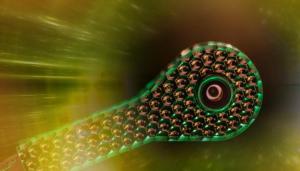
On the one-year anniversary of achieving a yield of more than 1.3 megajoules at LLNL’s National Ignition Facility, the scientific results of this record experiment have been published in three peer-reviewed papers: one in Physical Review Letters and two in Physical Review E. This stylized image shows a cryogenic target used for these record-setting inertial fusion experiments. Image by James Wickboldt/LLNL.
Feel the heat
The National Ignition Facility (NIF) uses the world’s largest laser to heat and compress a small capsule containing hydrogen fuel and thereby induce nuclear fusion reactions in the fuel, an approach known as inertial confinement fusion.
In early 2021, a team at NIF achieved a major milestone by showing that they could produce a burning plasma, a state in which the dominant source of fuel heating is self-heating due to fusion reactions — rather than external heating by the laser pulses. Later in 2021, NIF reported that they reached another milestone in fusion research: they produced a plasma in which self-heating locally surpasses not only the external heating but also all loss mechanisms, fulfilling the so-called Lawson criterion for fusion ignition.
The result brings the scheme tantalizingly close to a holy grail of the field — getting fusion to produce a net energy greater than that contained in the driving laser pulses.
On the one-year anniversary of this historic achievement, the scientific results of this record experiment have been published in three peer-reviewed papers. The papers describe, in detail, the results from Aug. 8, 2021 and the associated design, improvements and experimental measurements.

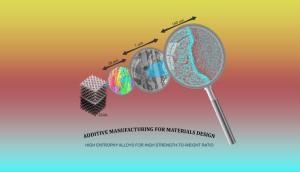
Researchers at Lawrence Livermore National Laboratory, Oak Ridge National Laboratory and several universities used a common laser-based metal 3D printing method to produce a new class of high entropy alloys that demonstrated both high yield strength and high ductility beyond other state-of-the-art 3D printed metal alloys.
No need to handle with care
Researchers at Lawrence Livermore, Oak Ridge National Laboratory and several universities have 3D printed a dual-phase, nanostructured, high-entropy alloy that exceeds the strength and ductility of other additively manufactured materials, which, they say, could lead to higher-performance components for applications in aerospace, medicine, energy and transportation.
Recent classes of metallic alloys — high-entropy alloys (HEA) or multi-principal elements alloys (MPEAs) — are allowing materials scientists to investigate a vaster space of compositions to further develop the next generation of alloys. The work has allowed scientists to make materials that are composed of two different main phases — one giving the materials strength, the other ductility. Distributing these different phases finely and homogenously are key to increasing the strength while limiting the loss in ductility, according to researchers.
Seeking the best of both worlds, a materials scientist at LLNL and collaborators have used the laser powder bed fusion method to produce a class of eutectic HEAs (EHEAs) demonstrating both high-yield strength and high ductility, beyond other state-of-the-art 3D printed metal alloys. The team also built lattice structures and other engineering components from the material, proving the viability of the technique.

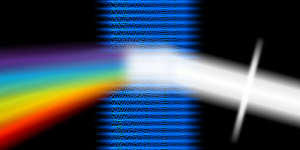
Petawatt lasers emit pulses whose power—for an instant—vastly exceeds the average power of the entire U.S. electric grid.
Plasma lasers pack a punch
Petawatt lasers emit pulses whose power — for an instant — vastly exceeds the average power of the entire U.S. electric grid. Such powerful pulses can be used to accelerate particles, create antimatter jets and generate X-ray beams. Pulse damage of the optical components used in these lasers, however, limits the highest achievable power and makes these systems extremely bulky — the laser beams must have large widths to prevent damage.
Matthew Edwards of Stanford University and Pierre Michel of Lawrence Livermore National Laboratory theorize that high-power lasers could be built using optics made of plasma, which can withstand much-higher-intensity beams than conventional materials.
Today, plasma optics, such as mirrors, are commonly used at petawatt laser facilities. But researchers have yet to demonstrate other components key to engineering a short-pulse plasma laser, including plasma gratings. Such gratings could substitute the solid gratings currently used to compress laser pulses and boost their peak power to petawatt levels.
Combining analytical calculations and numerical simulations, Edwards and Michel show that a plasma grating could be created by shining low-power lasers onto a plasma to induce a small, periodic modulation in the plasma’s refractive index. The predictions indicate that such a grating would have a damage threshold over 10,000 times higher than that of a conventional grating. It also could enable the building of lasers with 100 times more power than current systems but with the same size.

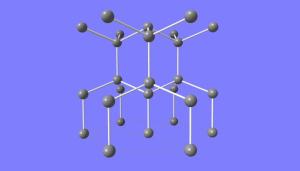
The hexagonal polytype of diamond called Lonsdaleite has been observed in shock compressed material after meteorite impacts.
From graphite to diamonds in picoseconds
The graphite-diamond phase transition is of particular interest for fundamental reasons and a wide range of applications.
On very fast compression time scales, material kinetics hinder the transition from graphite to the equilibrium cubic diamond crystal structure that we commonly know as diamond. Shock wave compression of graphite typically requires pressures above 50 GPa (500,000 atmospheres) to observe the phase transition on the time scale of shock compression experiments. Further, the hexagonal polytype of diamond called Lonsdaleite has been observed in shock compressed material subsequent to meteorite impacts, suggesting that the time scale of compression plays a strong role in the phase transition.
In new experiments, Lawrence Livermore scientists have emulated the conditions of Lonsdaleite formation using picosecond time scale laser compression and observed the transition with state-of -the-art material characterization using femtosecond X-ray pulses.
The observation of Lonsdaleite subsequent to shock compression has been a persistent mystery, including debate over whether hexagonal diamond exists as an extended structure, or is cubic diamond with defects.

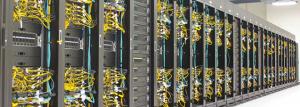
The Quartz supercomputer at Lawrence Livermore National Laboratory.
Managing the stockpile
Researchers from Lawrence Livermore’s Energetic Materials Center and Purdue University’s Materials Engineering Department have leveraged LLNL supercomputing to better understand the chemical reactions that detonate explosives that are “critical to managing the nation’s nuclear stockpile.”
The explosive materials in question are those based on triaminotrinitrobenzene (TATB), a high explosive that is insensitive to shock and which LLNL has characterized as “virtually invulnerable to significant energy release in plane crashes, fires, or explosions or small arms fire.” TATB — which is expensive to produce — is almost entirely used for the detonation of nuclear weapons.
But the mechanisms of TATB’s invulnerability had remained relatively opaque — until now. Researchers did know that the explosions resulted from “hotspots” created by shockwaves hitting defects in the material and causing temperature spikes, but models struggled to reproduce much beyond that basic understanding.
To change that, the researchers turned to the Quartz supercomputer at LLNL. On Quartz, the researchers conducted atomically resolved molecular dynamics simulations in an effort to simulate the formation of these hotspots and their explosive reactions.





